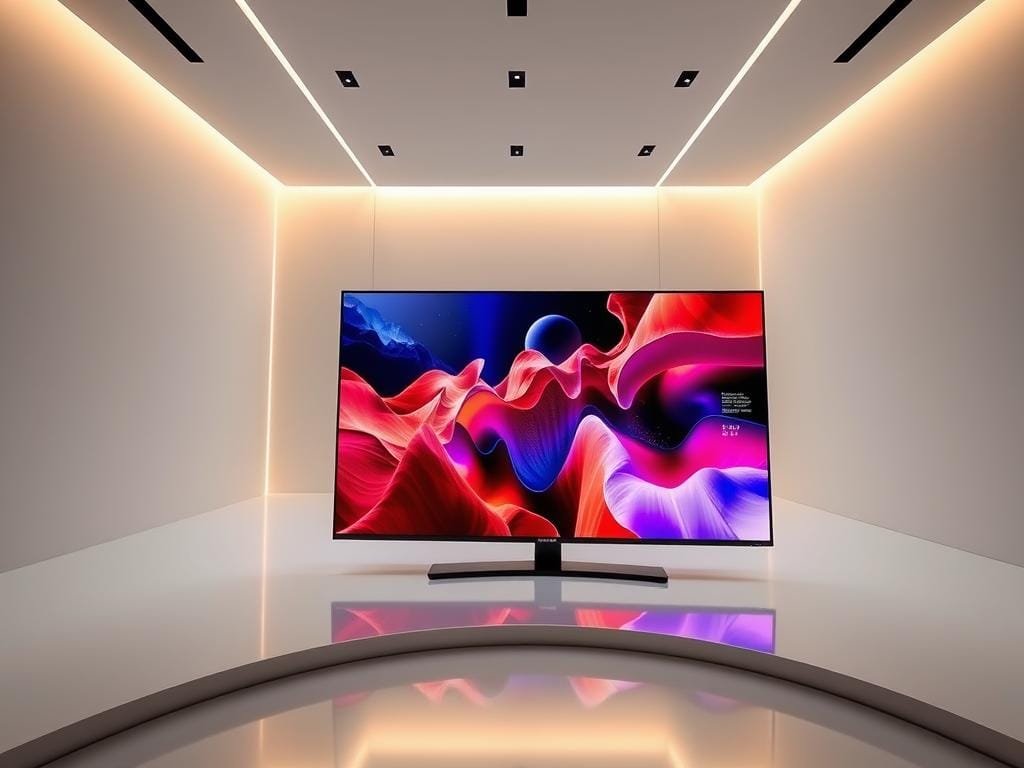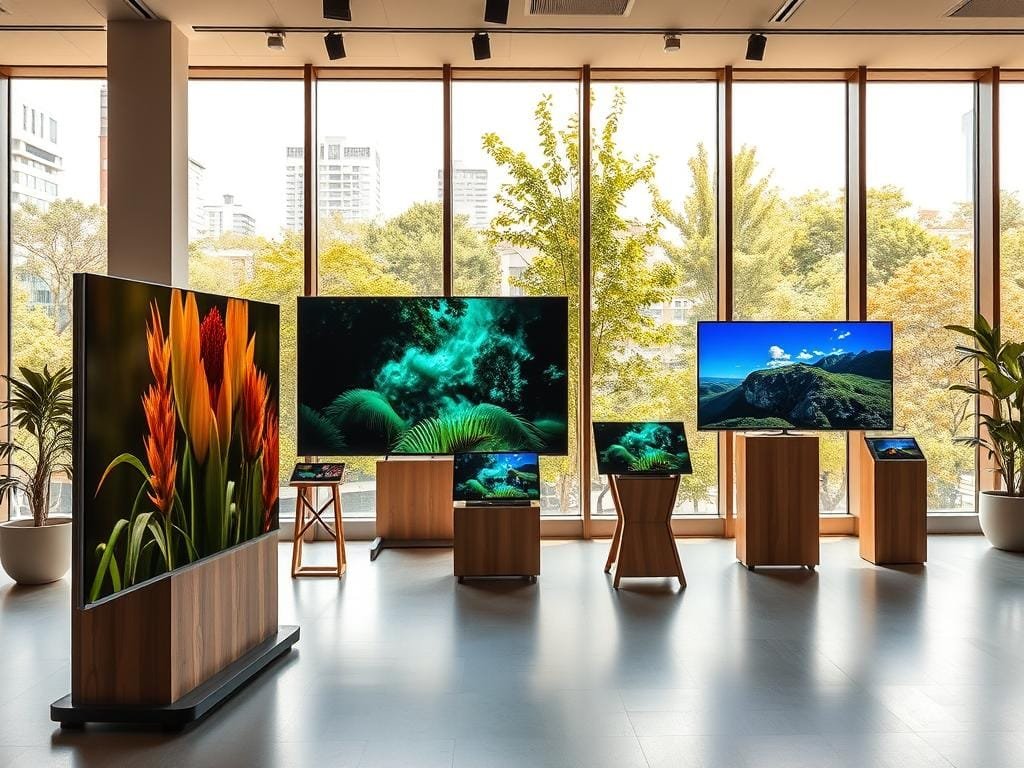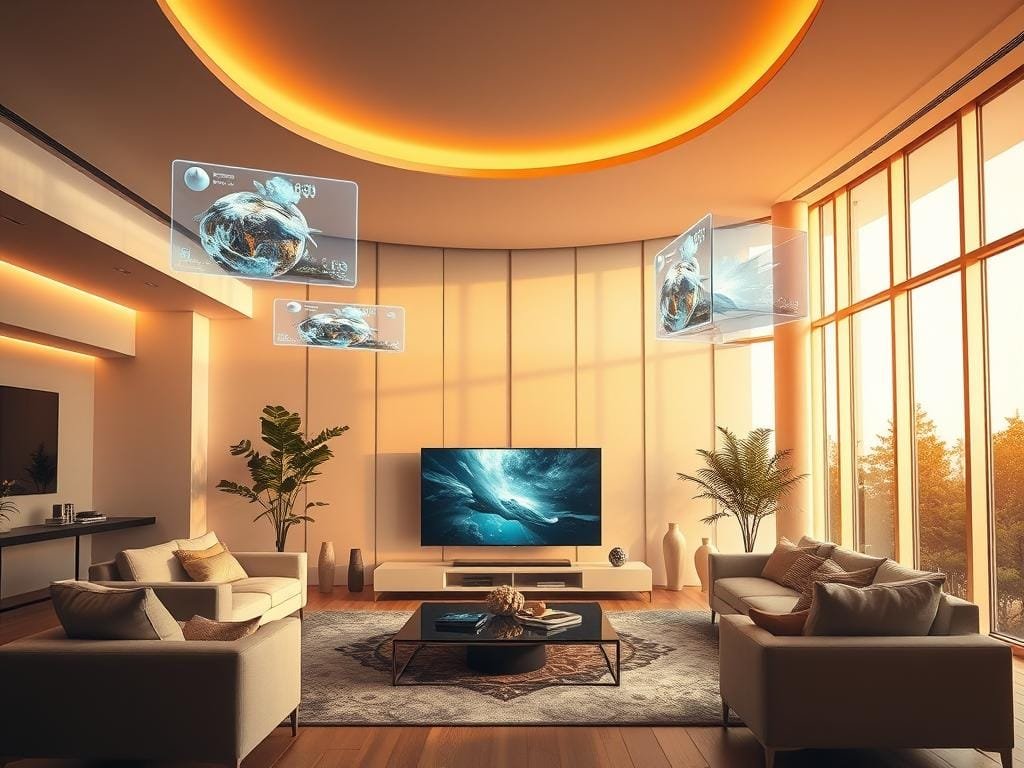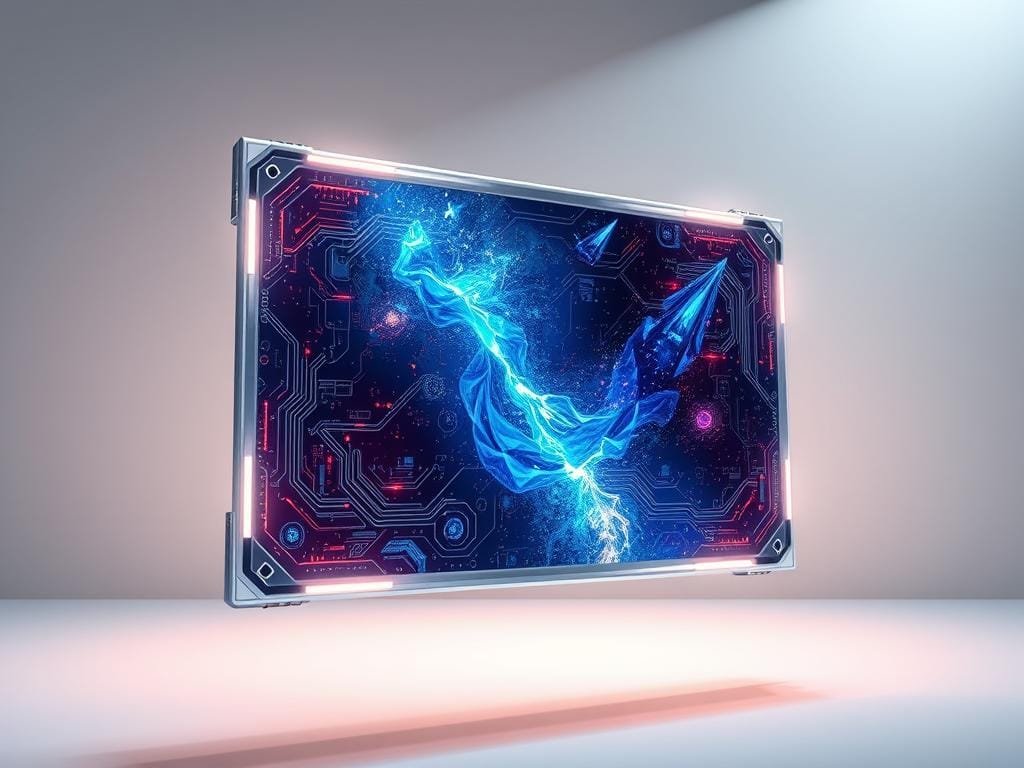You’ve probably heard about the latest in TV display technology, like 8K resolution. 8K resolution TVs have four times the pixels of 4K TVs. They have 33 million pixels, making the visuals more immersive.
The TV industry is on the verge of a big change. This change comes from new display technology. The next TVs and monitors will use AI, be more interactive, and have new display innovations.
Key Takeaways
- The future of TVs and monitors lies in advanced display technology beyond 8K.
- Innovations in AI and interactivity are set to revolutionize the viewing experience.
- The HDMI2.1b specification supports a bandwidth of up to 48Gbps, enabling features like Dynamic HDR and Wide Color Gamut.
- The Ultra High Speed HDMI Cables can deliver uncompressed native 8K@60Hz content.
- The future of display technology promises a more engaging and tailored experience for viewers.
The Evolution of Display Technology
Display technology has evolved a lot, from CRT to OLED and QLED. TVs and monitors have changed a lot over the years. Modern display technology has made big steps forward.
From CRT to LCD: A Brief History
The first big change was from CRT to LCD. CRTs were big and heavy, while LCDs were sleek and used less energy. This change started a trend towards thinner designs and better pictures.
As LCDs got better, they improved in resolution and how fast they could change images. But, they had some problems like bad viewing angles and contrast. Later, new technologies tried to fix these issues.
The Rise of OLED and QLED Technologies
OLED and QLED technologies were big steps forward. OLEDs are known for their true blacks and wide viewing angles. QLEDs, on the other hand, improved color and brightness.
Both OLED and QLED have made pictures better, with more vivid colors and a more immersive experience. For more on display technology history, check out AzumoTech’s resource center.
Understanding the Shift to 4K and 8K
The move to 4K and 8K shows how display tech keeps getting better. 4K has more pixels, making images sharper. 8K has even more, with four times the pixels of 4K.
When thinking about getting a new TV or monitor, knowing about these changes helps. Higher resolutions are part of the display technology trends that are changing how we watch things.
Current State of Display Technology
Exploring the latest display technology shows us how far we’ve come. Modern display technology is making visuals better than ever. We’re seeing big improvements in many areas, making our viewing experience better.
Resolution Trends in TVs and Monitors
TVs and monitors are getting much clearer. We’re seeing more 8K resolution, which is way clearer than before. This trend is likely to keep going, thanks to new display technology ideas.
| Resolution | Pixel Density | Typical Use |
|---|---|---|
| 1080p (Full HD) | 2.07 MP | General Use |
| 4K (Ultra HD) | 8.29 MP | High-End TVs and Monitors |
| 8K (Ultra HD) | 33.18 MP | Premium TVs and Professional Monitors |
Refresh Rates and Response Times
Refresh rates and response times are key for smooth viewing. They’re important for fast content like sports and games. Modern displays are getting better in these areas, making motion smoother.
Refresh Rate: This is how many times the screen updates per second. Higher rates mean a smoother view.
Response Time: This is how fast a pixel changes color. Faster response times mean clearer motion.
Color Accuracy and HDR Standards
Color accuracy and HDR are making displays look better. HDR adds more colors and contrast, making things feel more real.
- HDR10: An open-standard HDR format widely supported.
- HDR10+: An enhanced version of HDR10, with dynamic metadata.
- Dolby Vision: A proprietary HDR format with advanced color and metadata.

The latest in display technology solutions is all about better visuals. As tech keeps getting better, we’ll see even more amazing displays soon.
What Lies Beyond 8K: Upcoming Innovations
The future of display technology is exciting. We’re on the cusp of big changes in resolution, display tech, and artificial intelligence. These advancements will transform how we watch and interact with screens.
The Promise of 16K Resolution
16K resolution is the next big thing. It has 15360 x 8640 pixels, four times more than 8K. This could change how we enjoy visuals.
A report by Interdigital says high-definition tech is evolving. It’s not just about higher resolution but also being eco-friendly.
Advancements in MicroLED Technology
MicroLED tech is making huge strides. It uses tiny LEDs for better contrast, wider angles, and less power use. This is a big leap from traditional LED/LCD TVs.
| Technology | Resolution | Contrast Ratio |
|---|---|---|
| MicroLED | Up to 16K | 1,000,000:1 |
| OLED | Up to 8K | 1,000,000:1 |
| LCD | Up to 8K | 3,000:1 |
The Role of Artificial Intelligence
Artificial intelligence (AI) is key in display tech now. AI improves picture quality in real-time. It adjusts settings for better viewing and even guesses what we like.
“AI-driven display technology is set to revolutionize how we interact with visual content, making it more personalized and immersive.”
Looking ahead, AI, MicroLED tech, and higher resolutions like 16K will change display tech. They promise more engaging and sophisticated viewing experiences for us all.
The Impact of Display Technology on Gaming
When you start playing games, you quickly see how display technology changes everything. New display tech makes games feel more real and fun.
Enhancing Gaming Experiences
Today’s display tech aims to pull you into the game. High refresh rates, quick response times, and vivid colors all help. “The right display can make all the difference in your gaming performance,” a gaming pro notes.
Technologies like OLED and QLED bring games to life with deeper colors and contrasts. They also cut down on motion blur and boost visual quality.
Refresh Rate and Input Lag Considerations
In gaming, refresh rate and input lag are key. A high refresh rate, like 144Hz or 240Hz, makes games smoother. Low input lag means your actions show up fast, vital for quick games.
Look for displays that offer both high refresh rates and low input lag. This combo can give you an edge in multiplayer games.
The Growing Importance of Variable Refresh Rates
Variable Refresh Rate (VRR) tech is getting more attention in gaming. VRR lets the display adjust its refresh rate to match the game’s frame rate. This cuts down on screen tearing and makes games smoother.
Systems like NVIDIA G-Sync and AMD FreeSync show VRR in action. They make sure the display and graphics card work well together, improving your gaming.
Display Technology in Professional Environments
Advanced display technology is changing how professionals work in areas like graphic design, medical imaging, and simulations. As tech gets better, the need for top-notch displays grows. These displays must be precise, clear, and reliable.
Importance of Color Accuracy for Designers
For graphic designers, getting colors right is key. Advanced display technology gives the color accuracy needed for designs to look right everywhere. This is vital for those who need their work to look the same in print or online.
Designers need displays that show a wide range of colors and stay consistent. OLED and IPS are great because they bring out bright colors and deep blacks. This makes them perfect for graphic design.
Use in Medical Imaging and Simulations
In medical imaging, display technology solutions are vital for making diagnoses and treatments. High-resolution displays let doctors see detailed images, which is key for accurate diagnoses. The clear and precise images from advanced displays can greatly improve patient care.
Simulations, for training in medicine or other fields, also need advanced display tech. High-refresh rates and quick response times make simulations feel real. This is very important in fields like aviation and surgery, where realistic training can save lives.
Also, display technology applications in these areas are leading to new things like 3D visualization and virtual reality (VR) environments. These technologies are changing how professionals train and work with complex data.
Consumer Preferences and Trends
The display technology market is changing fast. People want smarter and greener products. So, makers are adding cool features to their displays.
The Role of Smart Features in Modern Displays
Smart features are now common in displays. They include voice control, gesture recognition, and seamless connectivity with smart devices. People want displays that fit well with their smart homes and improve their viewing.
Artificial Intelligence (AI) is also key in modern displays. AI helps make pictures better, saves energy, and guesses what you might like. This makes displays easier to use and more efficient.
| Smart Feature | Description | Benefit |
|---|---|---|
| Voice Control | Control your display with voice commands | Enhanced convenience |
| Gesture Recognition | Navigate through menus with hand gestures | Increased interactivity |
| Seamless Connectivity | Easily connect to other smart devices | Streamlined entertainment experience |
Eco-Friendly Display Technology
Eco-friendly display tech is getting popular. People care more about the planet. So, makers are making displays that use less energy and are made from green materials.
One big trend is using energy-efficient panels and recyclable components. These help the planet and save money on bills.

As people keep choosing green tech, the demand will keep rising. Companies that keep up with these trends will do well in the future.
Emerging Technologies: What to Watch
New display technologies are changing how we see and interact with screens. Looking ahead, many exciting innovations are set to change the display world.
Foldable and Rollable Displays
Foldable and rollable displays are big steps forward. They make devices more flexible, allowing them to change shape for different uses. For example, a phone that turns into a tablet is more useful.
Benefits include being more portable and having bigger screens without being bulky. But, making them durable and affordable is key for them to become common.
Transparent Displays and Their Applications
Transparent displays are also on the rise. They let digital info blend with the real world, creating deep experiences. They could be in smart windows or AR glasses, changing how we see things.
Using them in augmented reality is thrilling. It could change education, entertainment, and shopping by making things more interactive and fun.
As these techs grow, they’ll shape the future of display technology. Staying updated on these trends is vital for understanding the industry’s future.
Display Technology in the Home of the Future
Imagine stepping into a home where technology is part of the decor. The future of home design is about more than looks. It’s about adding tech that makes life better.
Integrated Displays in Smart Furniture
Smart furniture is getting popular, with tech playing a big role. Picture a coffee table that shows your favorite photos or a mirror that displays your day’s schedule.
Benefits of Integrated Displays include better decor and easy access to info or fun, without extra gadgets.
- Interactive surfaces for a more immersive experience
- Seamless integration with smart home systems
- Customizable displays to suit personal preferences
What 8K and Beyond Means for Home Theaters
8K and higher resolutions are changing home theaters. With 8K resolution, you’ll see incredible detail, like you’re right in the action.
| Resolution | Pixel Count | Viewing Experience |
|---|---|---|
| 4K | 3840 x 2160 | Highly detailed, suitable for most viewing distances |
| 8K | 7680 x 4320 | Extremely detailed, ideal for immersive viewing experiences |
The future of home theaters is about more than just high resolution. It’s about advanced sound and interactive features that make watching more fun.

As tech advances, we’ll see new uses in our homes, from smart furniture to top-notch theaters. The goal is to make these techs a natural part of our lives.
The Role of Streaming Services in Shaping Displays
Streaming services are changing the future of display technology. They are pushing for better displays to show off their high-definition content.
High-Quality Content: The Need for Better Displays
Streaming services offer high-quality content. This has made viewers want to see movie-quality visuals at home. They now look for displays with better resolution, higher refresh rates, and more accurate colors.
“The quality of the content is directly tied to the quality of the display,” says a leading industry expert. “As streaming services continue to invest in high-quality content, the need for advanced display technology will only continue to grow.”
Streaming Services and Display Technology
Netflix and Amazon Prime are leading this change. They produce high-quality content and push for new display technologies. For example, Netflix supports HDR technology for better contrast and color.
Compatibility with Next-Gen Formats
Displays also need to work with new formats. Streaming services are using more advanced codecs and formats. Displays must support these to ensure smooth playback.
Manufacturers are adding new technologies to their displays. They include support for VRR and ALLM. These features are key for gaming and fast-paced content.
In conclusion, streaming services are not just changing what we watch. They are also driving the need for better display technology. The relationship between streaming services and display technology will keep shaping home entertainment.
Challenges Facing Display Technology
Display technology is always changing, but it faces many challenges. As a user or professional, you might know about these quick changes. Yet, there are big obstacles to get past.
Cost Factors in High-End Displays
High-end displays are very expensive. The benefits of display technology are clear, but the cost stops many from using them. Companies are trying to make these displays cheaper by making more and improving how they’re made.
The newest displays with cool features like 8K resolution or OLED panels are pricey. This is because of the complex tech and high production costs. But, as tech gets better and competition grows, prices should drop. This will make modern display technology more affordable.
Overcoming Bandwidth Limitations
Another big problem is bandwidth limits. As displays get better, they need more data to work well. This can cause problems with how fast data moves.
To fix this, companies are working on display technology solutions that need less bandwidth. They’re improving HDMI, making data transfer faster, and creating new ways to connect displays.

Knowing about these challenges and the work to solve them helps you make better choices. Whether you’re into gaming, design, or just love great visuals, display tech will keep getting better. It will make your viewing experience even more amazing.
Choosing the Right Display Technology for You
Your perfect display is out there; you just need to know what to look for. With the rapid advancements in display technology applications, making an informed decision can be challenging.
When considering a new display, several factors come into play. Understanding these elements is key to selecting the right advanced display technology for your needs.
Factors to Consider When Buying a New Display
Before making a purchase, consider the following key factors:
- Resolution: If you’re looking for crisp and clear images, consider the resolution. 4K and 8K are popular choices for their high-quality visuals.
- Refresh Rate: For smoother motion, a higher refresh rate is essential, which is important for gamers.
- Connectivity: Ensure the display has the right ports to connect to your devices, such as HDMI or USB-C.
- Size and Aspect Ratio: The size and aspect ratio should fit your viewing needs and the space available.
As noted by industry expert,
“The future of display technology is not just about resolution; it’s about creating an immersive experience.” –
The Best Options for Various Use Cases
Different use cases demand different display technologies. Here’s a breakdown:
| Use Case | Recommended Display Technology | Key Features |
|---|---|---|
| Gaming | High Refresh Rate LCD or OLED | Fast response time, high refresh rate |
| Graphic Design | 4K or 8K IPS or OLED | High color accuracy, wide color gamut |
| Home Theater | OLED or High-End LED | High contrast ratio, HDR support |
When it comes to modern display technology, the options are vast and varied. By understanding your specific needs and how different technologies can meet those needs, you can make a more informed decision.
Ultimately, the best display for you will depend on your specific requirements. Whether it’s for gaming, professional use, or entertainment, consider the factors outlined above and explore the latest advanced display technology. You’ll be well on your way to finding the perfect display.
Conclusion: The Future is Bright (and High-Definition)
The future of display technology is moving fast. We’re seeing big changes in resolution, refresh rates, and color. From CRT to OLED and QLED, we’ve come a long way. Now, 4K and 8K resolutions are common.
Innovation Drivers
What drives these changes? It’s what people want. When you’re ready to upgrade, check out the latest trends. Look for 16K resolution and MicroLED technology. Artificial intelligence is also making displays better.
Embracing Next-Gen Displays
The future holds even more exciting features. We’ll see foldable, rollable, and transparent screens. These advancements will improve gaming, work, and home theaters. Keep up with display trends to enjoy a better viewing experience.
FAQ
What is the current state of display technology, and how is it evolving?
Display technology is changing fast. We’re seeing higher resolutions, faster refresh rates, and better color accuracy. New tech like OLED, QLED, and MicroLED is making viewing experiences better.
What are the benefits of higher resolutions like 4K and 8K?
Higher resolutions like 4K and 8K make images more detailed and clear. They’re great for gaming, video editing, and medical imaging.
How does HDR enhance the viewing experience?
HDR brings a wider range of colors, contrast, and brightness. This makes visuals more lifelike and engaging.
What is the significance of refresh rates and response times in gaming displays?
Refresh rates and response times are key for smooth gaming. Faster rates and lower response times reduce screen issues like tearing and blur.
How is artificial intelligence being used in display technology?
AI is improving display tech, mainly in image processing and color accuracy. It adapts to different content and environments, boosting the viewing experience.
What are the emerging trends in display technology, and how will they shape the future?
Trends like foldable, rollable, and transparent displays, along with MicroLED advancements, are changing the industry. They’ll bring new shapes, flexibility, and better visuals.
How will display technology be integrated into the home of the future?
Displays will be part of smart homes, with smart furniture, theaters, and immersive systems. This will make living more interactive and seamless.
What are the challenges facing display technology, and how are they being addressed?
Issues like cost, bandwidth, and compatibility are being tackled. New, affordable tech, better compression, and standards are helping.
How can I choose the right display technology for my needs?
Consider resolution, refresh rate, color, and HDR when choosing a display. Think about your needs, whether for gaming, work, or entertainment, to find the best fit.
What is the role of consumer demand in driving innovation in display technology?
Consumer demand is key in driving display tech innovation. As users want better displays, manufacturers innovate to meet these needs.
What can we expect from the next generation of displays?
Next-gen displays will have even higher resolutions, faster refresh rates, and advanced features like AI. These will open up new possibilities and enhance our viewing experiences.
